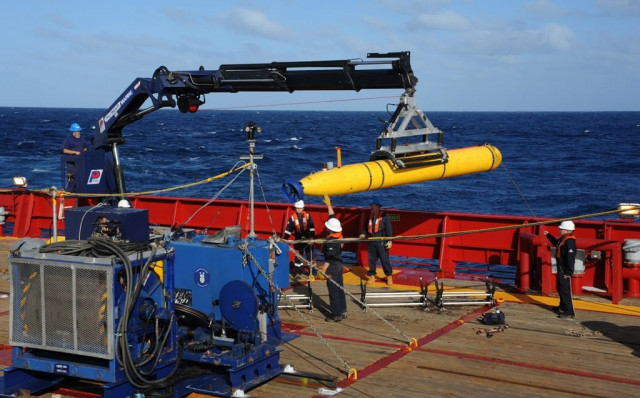Sonar loaded underwater robot to hunt for MH370
The Bluefin-21, a 16.2 feet long sonar device, is expected to be deployed to the ocean floor.

This handout image taken on April 1, 2014 and received on April 8, 2014 from the US Navy shows the Bluefin 21 Artemis autonomous underwater vehicle (AUV) being hoisted back on board the Australian navy vessel Ocean Shield after successful buoyancy testing in the Indian Ocean. PHOTO: AFP
The Bluefin-21, a 16.2 feet long sonar device, is expected to be deployed to the ocean floor in the days ahead to look for debris from Boeing 777, which vanished on March 8.
Angus Houston, who heads the agency coordinating the eight-nation hunt, said that after more work to detect "pings" consistent with those issued from aircraft black boxes the autonomous submersible could be deployed in the remote area off western Australia where the search is focused.
Once in the water, if the device detects something unusual using the sonar, it can be brought to the surface and sent down again equipped with a video camera to provide the visual evidence of a crash.
"You can't have the side sonar and the camera down there together, it's one or the other," the retired Air Chief Marshal Houston told the ABC.
"We will continue sortie after sortie until such time as we pick up evidence that there's something unusual on the ocean floor. We would then send down the camera.
"What we're after is wreckage, a debris field as people would say."
The device was designed for offshore surveying, search and salvage operations, archaeology and exploration, oceanography and mine countermeasures and its modest size makes it easy to transport.
But it will be a smallish device operating in a vast ocean search zone, and Houston said it would take a long time to find anything without more information about a possible crash site.
"It's a long, painstaking process, particularly when you start searching the depths of the ocean floor," he said.
The Bluefin-21 has not yet been sent down because it can not be deployed while the US Navy's towed pinger locator, the device attached to the Australian vessel Ocean Shield which had picked up the sounds, is in use.
But once the batteries in the black box recorders expire, something which is expected to occur in coming days given they have a life-span of about 30 days, the Bluefin-21 is expected to be deployed.
The device, which weighs 750 kilograms, can operate at a depth of up to 4,500 metres - the depth of the ocean floor where the pings were detected.
"It can't go deeper than that, so it's quite incredible how finely balanced all of this is," Houston said.
The US Navy has provided specialist Navy and civilian equipment operators who will join the ship's crew and Australian Defence Force specialists to deploy the equipment, authorities said.



















COMMENTS
Comments are moderated and generally will be posted if they are on-topic and not abusive.
For more information, please see our Comments FAQ